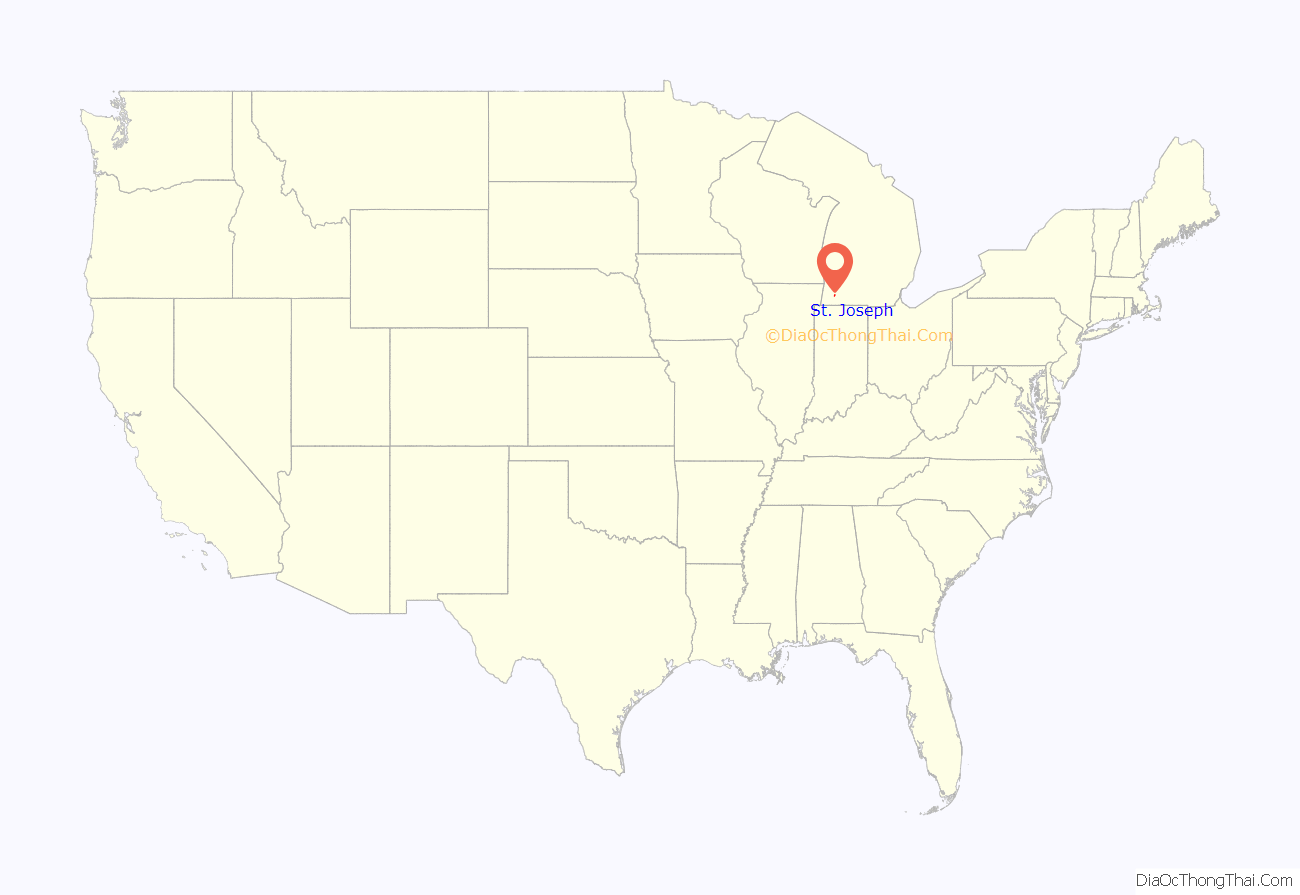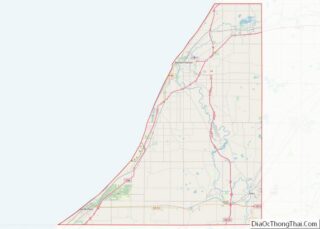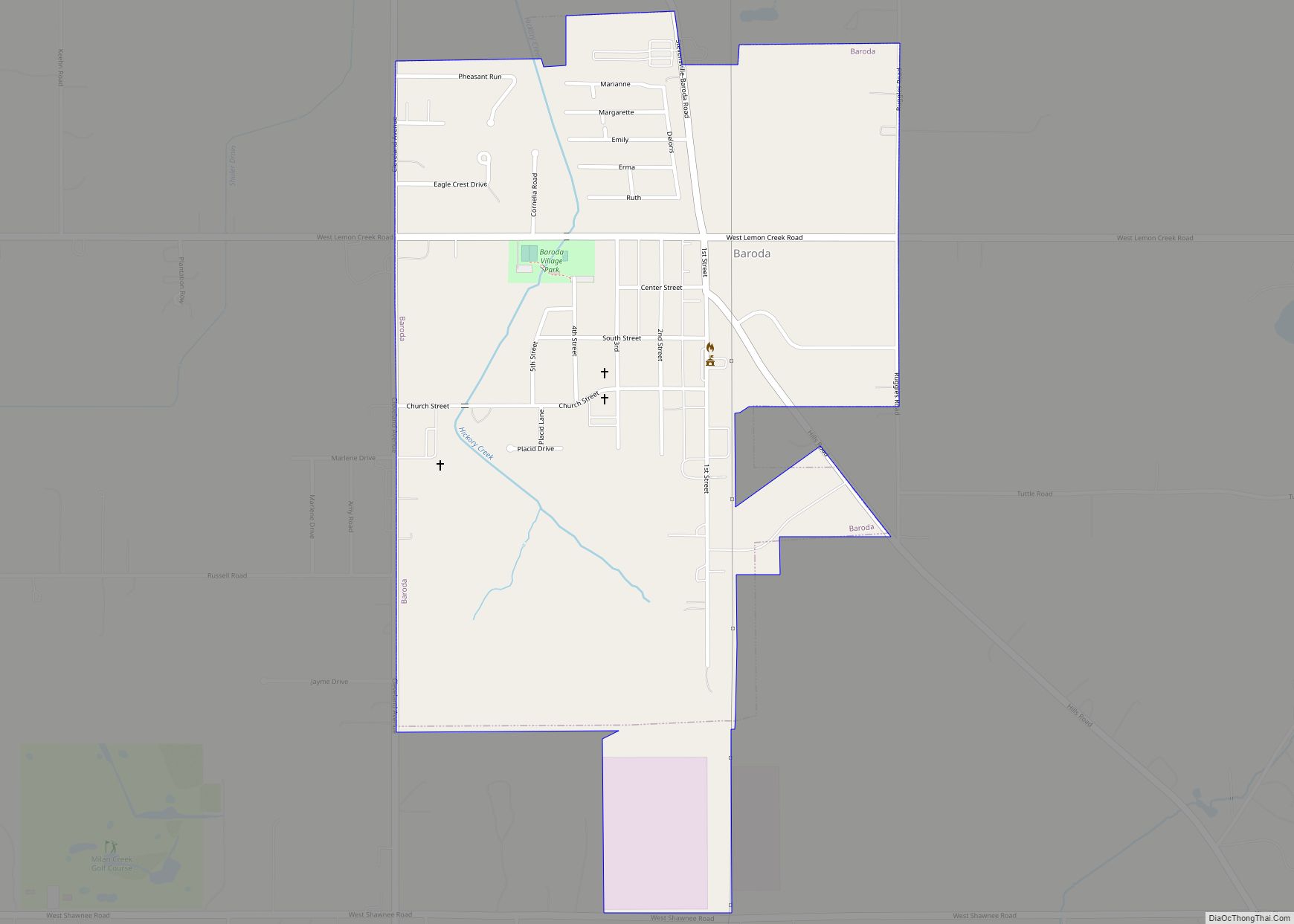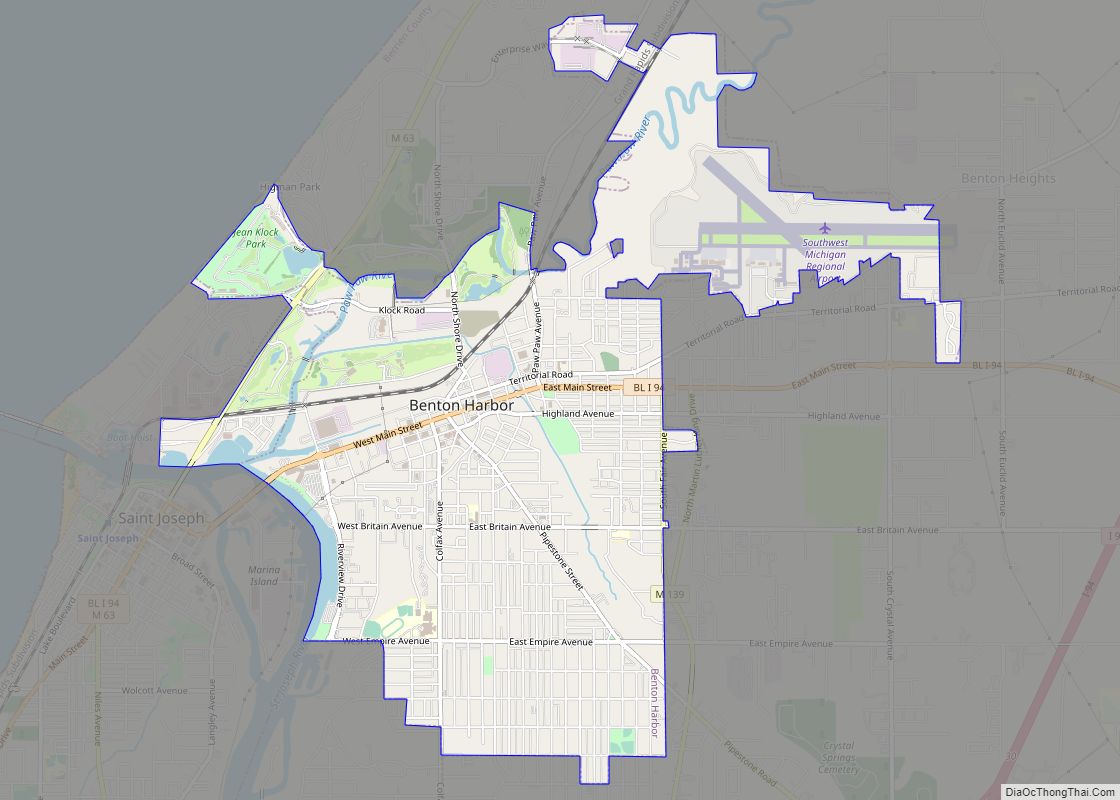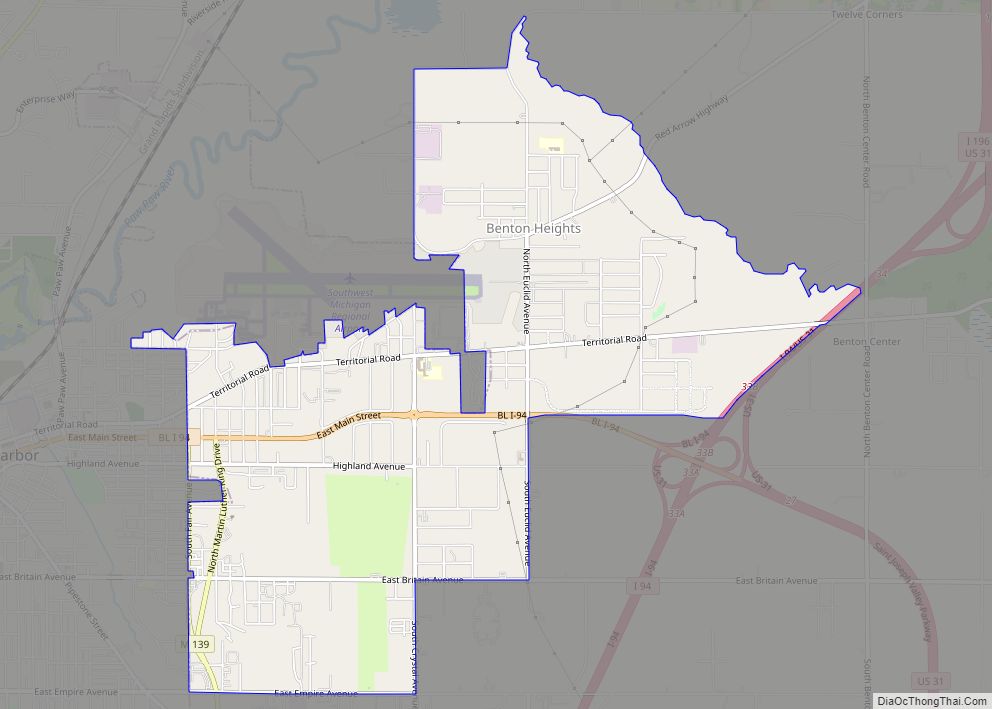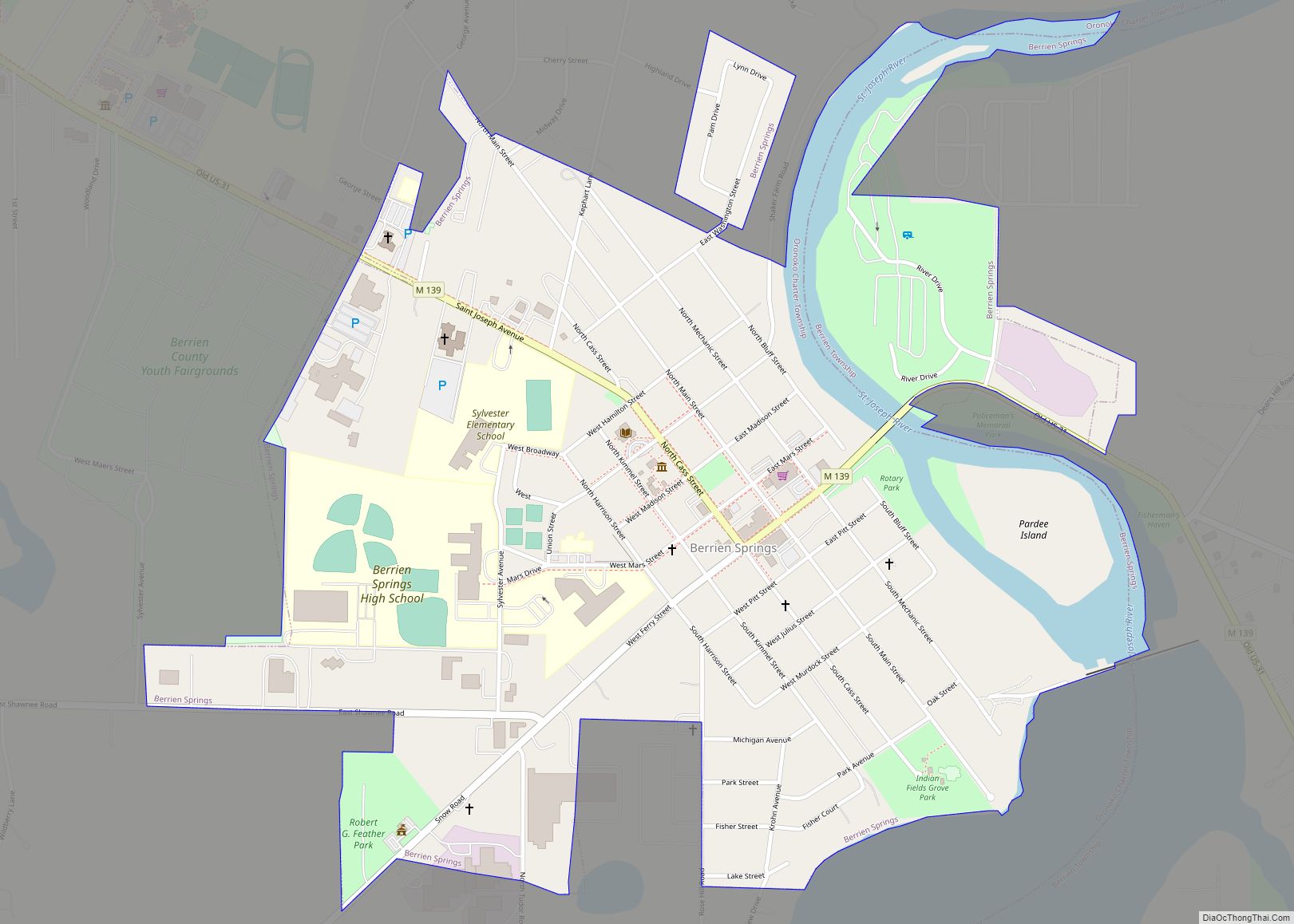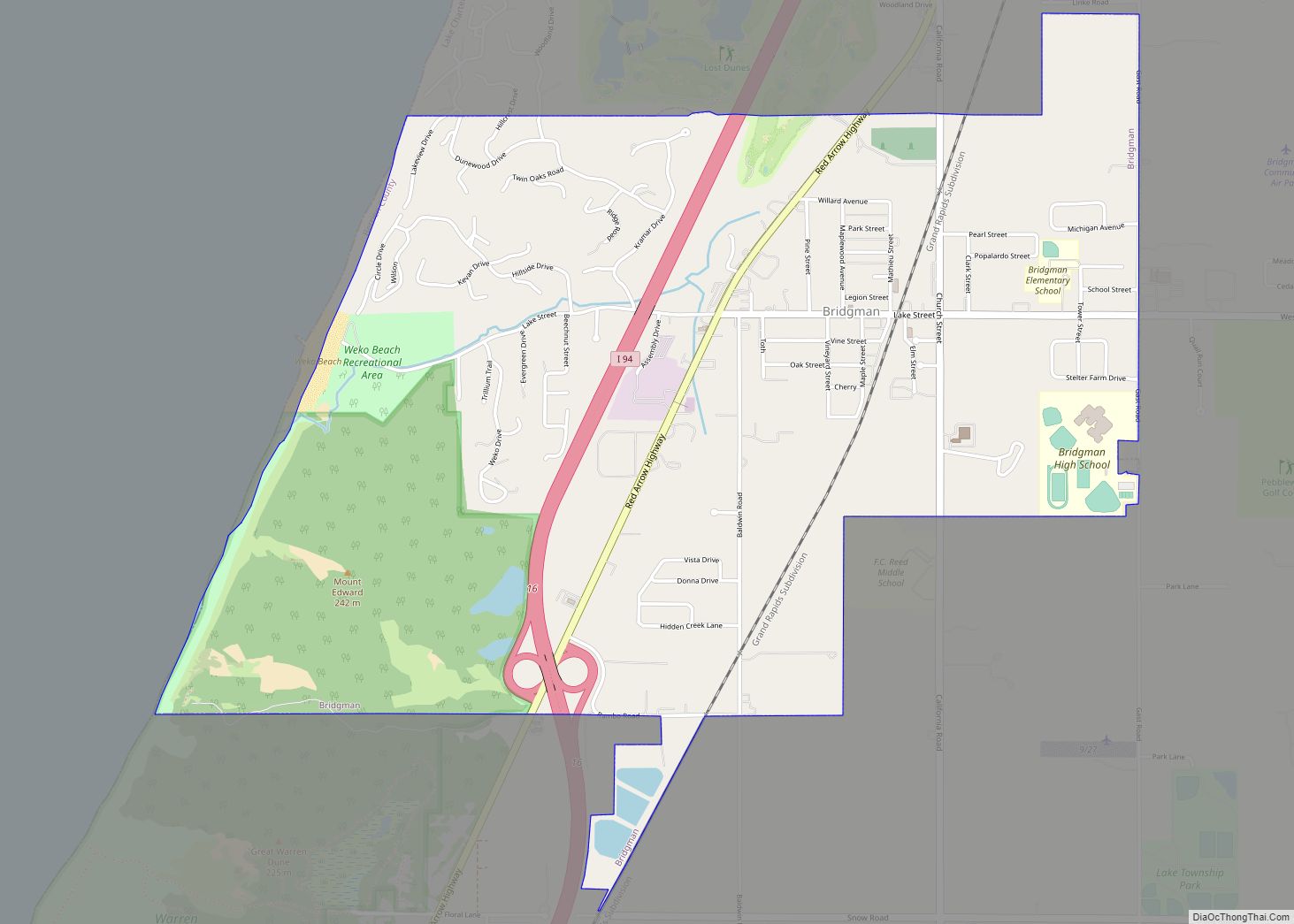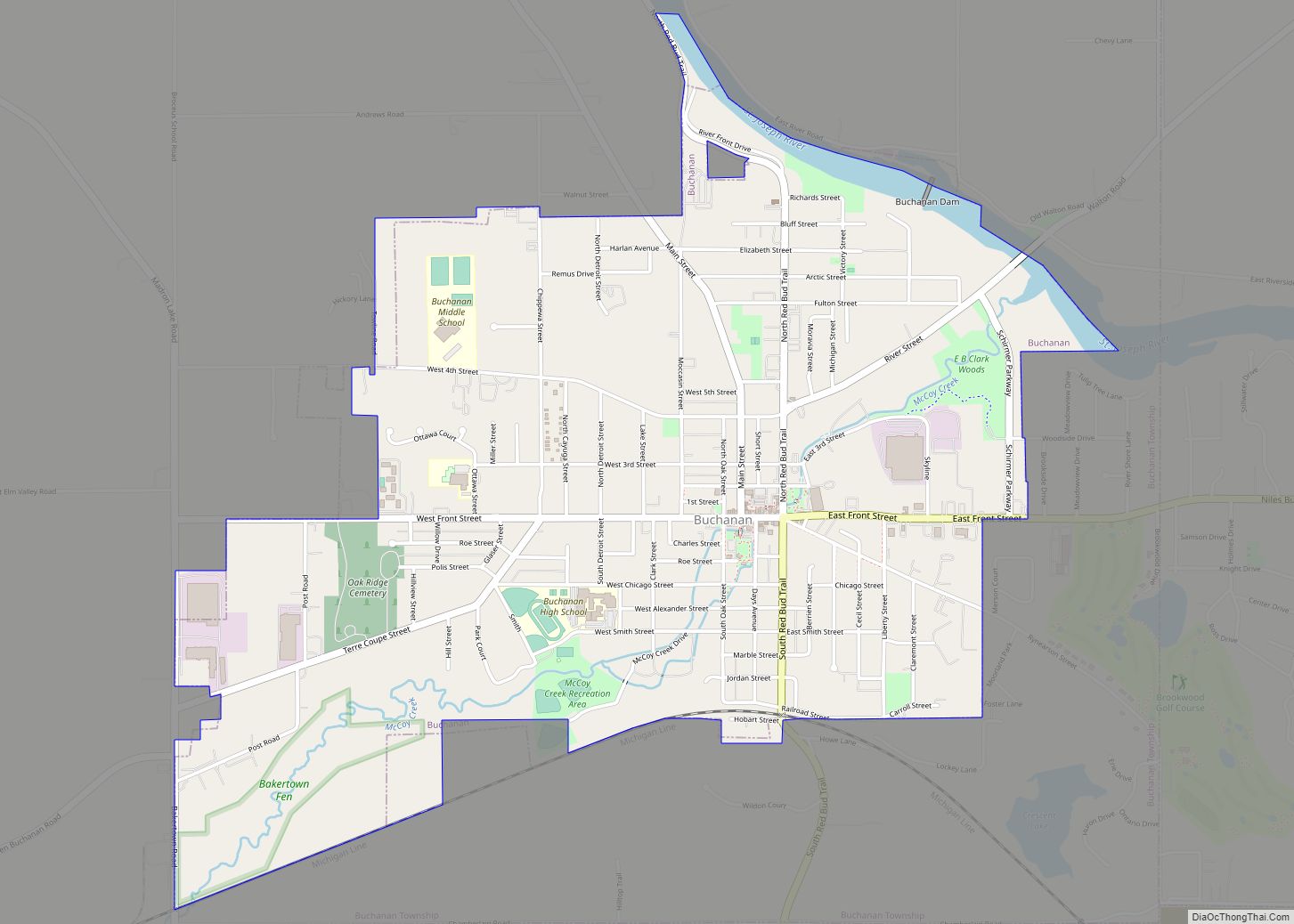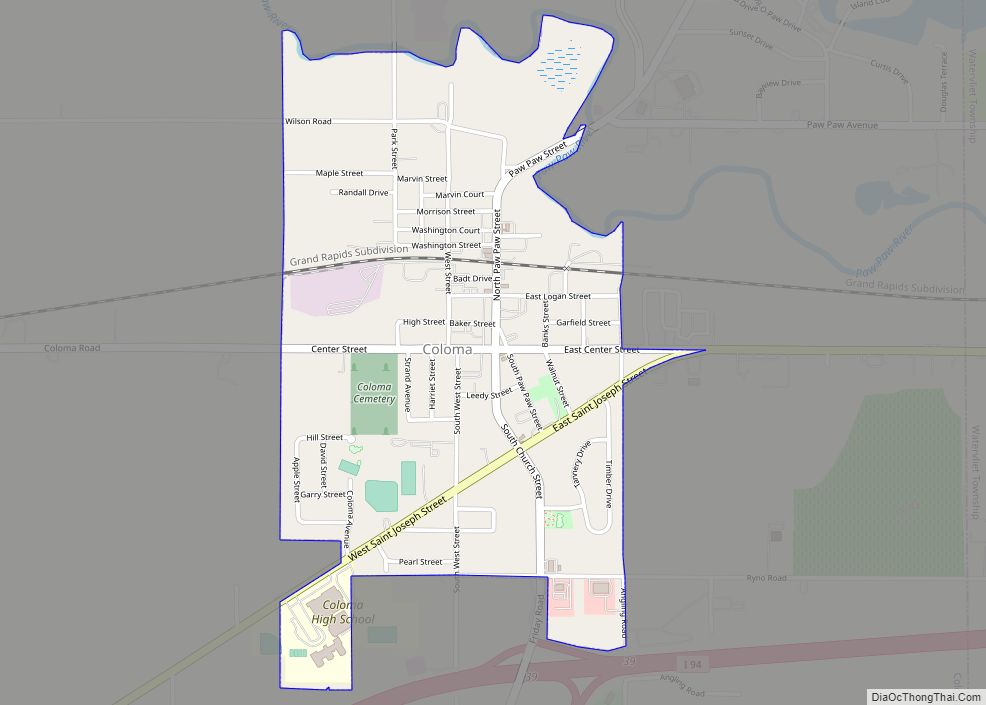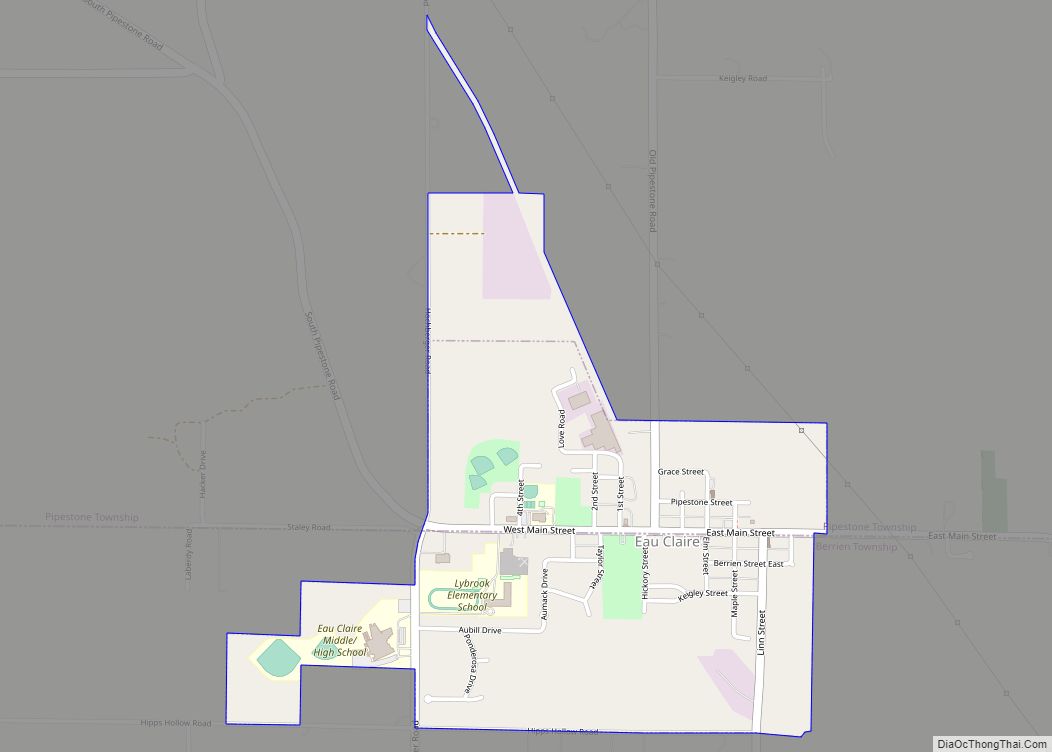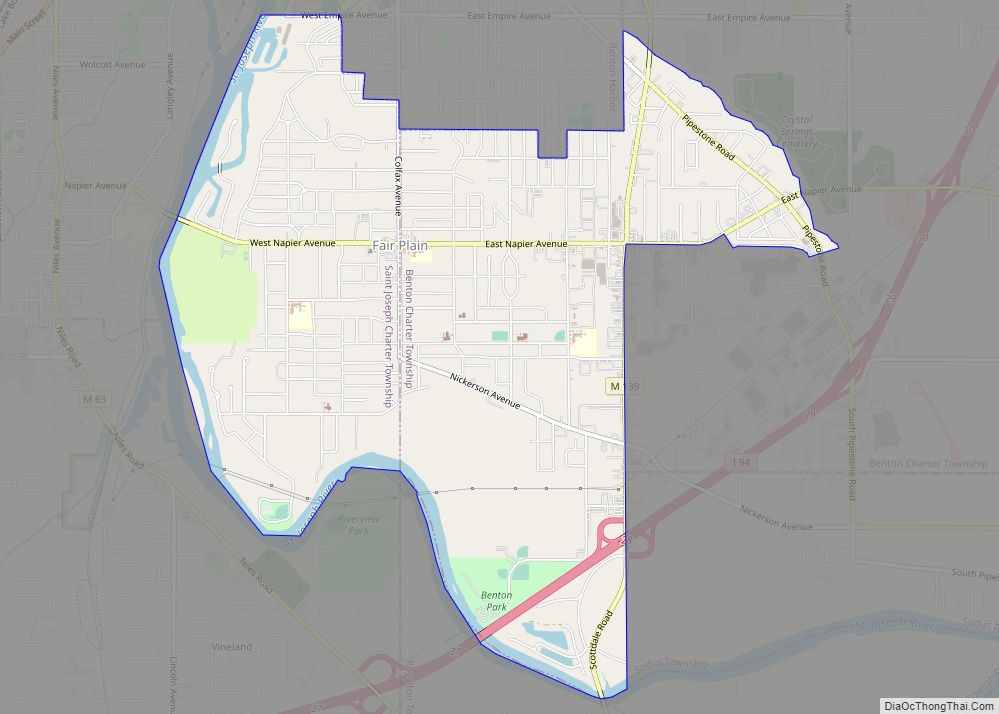St. Joseph, colloquially known as St. Joe, is a city and the county seat of Berrien County, Michigan. It was incorporated as a village in 1834 and as a city in 1891. As of the 2010 census, the city population was 8,365. It lies on the shore of Lake Michigan, at the mouth of the St. Joseph River, about 90 miles (140 km) east-northeast of Chicago. It is home of the American Society of Agricultural and Biological Engineers.
| Name: | St. Joseph city |
|---|---|
| LSAD Code: | 25 |
| LSAD Description: | city (suffix) |
| State: | Michigan |
| County: | Berrien County |
| Incorporated: | 1834 (village) 1891 (city) |
| Elevation: | 630 ft (192 m) |
| Total Area: | 4.78 sq mi (12.38 km²) |
| Land Area: | 3.20 sq mi (8.30 km²) |
| Water Area: | 1.58 sq mi (4.08 km²) |
| Total Population: | 7,856 |
| Population Density: | 2,452.70/sq mi (947.05/km²) |
| Area code: | 269 |
| FIPS code: | 2670960 |
| GNISfeature ID: | 0636762 |
Online Interactive Map
Click on ![]() to view map in "full screen" mode.
to view map in "full screen" mode.
St. Joseph location map. Where is St. Joseph city?
History
The mouth of the St. Joseph River at present day St. Joseph was an important point of Amerindian travel and commerce, as it lay along a key water route between the Great Lakes and the Mississippi River. Both the Miami and Potawatomi used this route and would use the area as a camp. The St. Joseph River also allowed for connection with the Sauk Trail, which was the major land trail through Michigan. In 1669, the mouth of the river was seen by European explorers. French explorer René-Robert Cavelier, Sieur de La Salle, built Fort Miami on the bluff overlooking Lake Michigan. In 1679, he waited for the ship Le Griffon, which never returned. Once the ship was deemed lost, La Salle and his men made the first land crossing of the lower peninsula by Europeans.
The next permanent white settler in St. Joseph was William Burnett, who around 1780 started a trading post at the mouth of the St. Joseph River. The post traded food, furs and goods with places including Detroit, Mackinac and Chicago. In 1829, Calvin Britain, who had come from Jefferson County, New York, and had taught at the Carey Mission at Niles for two years, came to the site of St. Joseph. Shortly thereafter, he laid out the plat of the village, then known as Newburyport, named after a coastal city in Massachusetts. Britain was influential in attracting other settlers to the area. Lots sold rapidly and the village flourished.
The St. Joseph river mouth was straightened through a channel and piers were added later. The first lighthouse in St. Joseph contends with Chicago’s original lighthouse as the first to be built on Lake Michigan. Newburyport changed its name to St. Joseph when it was incorporated on March 7, 1834. The city was incorporated June 5, 1891.
The first water route across Lake Michigan between St. Joseph and Chicago began as a mail route in 1825, but service was sporadic until 1842 when Samuel and Eber Ward began a permanent service. That lasted eleven years. Before the rise of large ship companies on Lake Michigan, service was done primarily by owner-operated boats. With the rise in shipping in Benton Harbor and the rise in tourism in St. Joseph, permanent and larger operations began operating out of the ports.
The Coast Guard still maintains a station on this site. In 1876 the United States Lifesaving Service built a Lifesaving Station at St Joseph, appointing Joseph Napier as the first stationkeeper.
After a bitterly fought political contest, St. Joseph was named the seat of Berrien County in 1894, when Berrien Springs relinquished that status. The three largest towns in the county, Benton Harbor, St. Joseph, and Niles, each wanted to be the county seat, but none had a majority vote. Once St. Joseph and Benton Harbor voters combined their votes, St. Joseph had enough to win.
On October 11, 1898, Augustus Moore Herring took one of his gliders, fitted with a motor, to Silver Beach in St. Joseph. Herring’s machine lifted ever so slightly off the ground and actually flew for seven seconds. Eleven days later, the inventor made another flight of ten seconds. While Herring had a powered heavier-than-air craft, he did not have a way to control it. It was left to the Wright brothers to perfect controlled flight five years later, and give themselves and Kitty Hawk, North Carolina, a place in history that might have ended up belonging to Herring and St. Joseph.
Transportation history
Two major shipping companies operated between St. Joseph and Chicago during the last half of the 19th century, the Goodrich Transportation company and the local firm of Graham and Morton. They dominated the traffic at St. Joseph for more than 100 years, although other smaller companies did operate during this time.
Starting in 1874, Henry Graham and J. Stanley Morton began operating a steam line out of St. Joseph. Their collaboration would become the Graham and Morton Transportation Company. Through vigorous competition, they won the war to become the major carrier out of St. Joseph. Goodrich stopped service to the Twin Cities in 1880. The company grew fast and over the fifty plus years of its existence became the second largest line on Lake Michigan behind only Goodrich.
In 1924, as graded roads began to line the Lake Michigan shoreline, G & M was forced to merge into Goodrich. Like most other ports along Lake Michigan, St. Joseph saw a huge drop in traffic during the early years of the twentieth century and this was exacerbated by the Great Depression. The route between Chicago and St. Joseph did survive until the 1950s.
On January 29, 1870, the Chicago and Michigan Lake Shore Railroad extended a rail line from New Buffalo to St. Joseph. This railroad connected St. Joseph to Grand Rapids, Muskegon, Detroit and Chicago. (Prior to this, the only connection St. Joseph had to these other cities was by water.) The line was reorganized as the Chicago and West Michigan Railway and then was incorporated into the Pere Marquette Railroad.
Business and industry history
In 1892, Truscott Boat Manufacturing Co moved to St. Joseph from Grand Rapids. In the early 20th Century, the company was the largest employer in St. Joseph with 700 employees and built 600 wooden boats per year. The company built boats for the government in World War I, struggled during the Depression, was sold in 1940, revived during World War II to build ships for the Navy and went bankrupt in 1948.
In 1911, Louis, Emory, and Frederick Upton began a business that produced household washing machines. The business soon became a boom and has continued to grow to this day. In 1929, Upton Machine Company merged with Nineteen Hundred Corp., taking the latter name. The company began marketing a line of appliances known as the “Whirlpool” brand in 1948. Within the next decade, Nineteen Hundred changed its name to Whirlpool. Today, Whirlpool Corporation is the largest manufacturer of major home appliances and maintains a large presence in St. Joseph and nearby Benton Harbor. Whirlpool has its world headquarters outside Benton Harbor.
In 1891 the Silver Beach Amusement Park was opened on land between the lake and mouth of the river in St. Joseph. Logan Drake and Louis Wallace bought the land from the Pere Marquette Railroad and added cottages to lure tourists to the lake front. As the park aged and grew in popularity, the pair added many attractions, including concessions, games, pool, a boardwalk and different rides. The first roller coaster was built in 1904 and was called the Chase Through the Clouds, which was replaced by the Velvet roller coaster (renamed the Comet). Among the most popular attractions were the carousel and the Shadowland Ballroom, built in 1927. During the 1960s and 1970s, the buildings decayed and the crowds decreased. Finally, crime in the park led police to shut it down in 1970.
St. Joseph Road Map
St. Joseph city Satellite Map
Geography
According to the United States Census Bureau, the city has a total area of 4.80 square miles (12.43 km), of which 3.22 square miles (8.34 km) is land and 1.58 square miles (4.09 km) is water.
See also
Map of Michigan State and its subdivision:- Alcona
- Alger
- Allegan
- Alpena
- Antrim
- Arenac
- Baraga
- Barry
- Bay
- Benzie
- Berrien
- Branch
- Calhoun
- Cass
- Charlevoix
- Cheboygan
- Chippewa
- Clare
- Clinton
- Crawford
- Delta
- Dickinson
- Eaton
- Emmet
- Genesee
- Gladwin
- Gogebic
- Grand Traverse
- Gratiot
- Hillsdale
- Houghton
- Huron
- Ingham
- Ionia
- Iosco
- Iron
- Isabella
- Jackson
- Kalamazoo
- Kalkaska
- Kent
- Keweenaw
- Lake
- Lake Hurron
- Lake Michigan
- Lake St. Clair
- Lake Superior
- Lapeer
- Leelanau
- Lenawee
- Livingston
- Luce
- Mackinac
- Macomb
- Manistee
- Marquette
- Mason
- Mecosta
- Menominee
- Midland
- Missaukee
- Monroe
- Montcalm
- Montmorency
- Muskegon
- Newaygo
- Oakland
- Oceana
- Ogemaw
- Ontonagon
- Osceola
- Oscoda
- Otsego
- Ottawa
- Presque Isle
- Roscommon
- Saginaw
- Saint Clair
- Saint Joseph
- Sanilac
- Schoolcraft
- Shiawassee
- Tuscola
- Van Buren
- Washtenaw
- Wayne
- Wexford
- Alabama
- Alaska
- Arizona
- Arkansas
- California
- Colorado
- Connecticut
- Delaware
- District of Columbia
- Florida
- Georgia
- Hawaii
- Idaho
- Illinois
- Indiana
- Iowa
- Kansas
- Kentucky
- Louisiana
- Maine
- Maryland
- Massachusetts
- Michigan
- Minnesota
- Mississippi
- Missouri
- Montana
- Nebraska
- Nevada
- New Hampshire
- New Jersey
- New Mexico
- New York
- North Carolina
- North Dakota
- Ohio
- Oklahoma
- Oregon
- Pennsylvania
- Rhode Island
- South Carolina
- South Dakota
- Tennessee
- Texas
- Utah
- Vermont
- Virginia
- Washington
- West Virginia
- Wisconsin
- Wyoming
